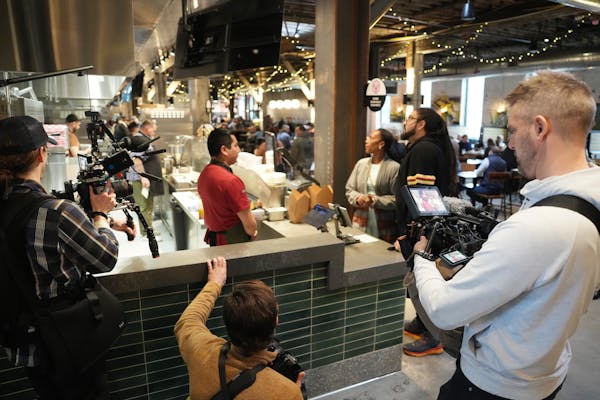ROCHESTER — Minnesotans got a first look Tuesday at the state's new ads touting tourism and a move to the Land of 10,000 Lakes that will launch in March — the largest nationwide marketing campaign the state has ever done.
The ads in the new "Star of the North" campaign aim to draw more visitors and new residents, and will launch March 4 in 22 states and Canada. Explore Minnesota, the state's tourism arm, unveiled the ads to travel industry experts at its annual conference in Rochester.
This is the first time Explore Minnesota is marketing beyond tourism, hoping to inspire Americans to consider relocating to Minnesota, with digital, TV and radio ads targeting communities such as Seattle, Boston and Austin, Texas. Separate tourism ads will air mostly in the Midwest as well as cities including Denver and Dallas.
"Our campaigns are going to showcase the best of our state," said Lauren Bennett McGinty, executive director of Explore Minnesota. "Minnesota can be the next positive chapter in their journey."
The effort is needed, leaders say, to keep up with other states' marketing efforts and fill critical jobs. Minnesota's 3.1% unemployment rate — lower than the national rate — means the state has more job openings than workers. Minnesota also loses more residents than it gains.
"This campaign allows us to stand out," Bennett McGinty said. "We want people across the country to know our secret: ... Life is better in Minnesota."
The national ad campaigns are part of new efforts at Explore Minnesota thanks to more than $25 million in extra funding the Legislature approved last year for the agency over the next two years, the first time its budget has increased in more than a decade and the largest investment ever.
Gov. Tim Walz said Minnesotans have long been humble and don't brag about the state, but he said now is the time to sell its merits. He and Lt. Gov. Peggy Flanagan addressed about 500 people at Tuesday's conference, the largest attendance in decades of it.
"Nothing drives me crazier than to see other states advertising here knowing that what we have here can compete anywhere," Walz said. "We need to tell the story ... This is the place to be."
The documentary-style ads feature influencers experiencing Minnesota for the first time such as female anglers from North Carolina catching walleye on Lake of the Woods after visiting the headwaters of the Mississippi River and dining at Krewe in St. Joseph. The livability campaign highlights recent transplants from other states, including Oregon and New York, who have moved to Sartell, Minneapolis and Duluth.
"Talent recruitment is so important," said Bill Von Bank of Experience Rochester, where the number of visitors has increased this year, nearing pre-pandemic levels. "Once you visit, maybe you'll move here. Every state wants that."
Of the new state funding to Explore Minnesota, $11 million is starting a new division called Explore Minnesota for Business, focused on economic development. The first phase is focused on attracting residents, followed by campaigns to lure new businesses and pitch students on staying here for college and after graduation. Minnesota loses more college students than it attracts.
More than half of the states in the country have livability campaigns like this, Bennett McGinty added.
"To date Minnesota has been too quiet on that," she said. "We haven't been doing a good job of marketing of what we have to offer those job seekers or business owners. But that is changing."
Most of the new funding, including for the new economic development division, is one-time funding this biennium. Bennett McGinty said she will likely be back at the state Capitol next year to ask legislators to sustain the funding.
"This is a long-term plan," she said. "This isn't just one and done. I'm hoping people see the effectiveness. I think people understand we need workers."
Walz said the state will continue to fund the agency's operation.
Minnesota's leisure and hospitality sector makes up the fourth-largest industry in the state, with about 250,000 employees at resorts, hotels, restaurants, museums and theaters. The COVID-19 pandemic devastated the sector, which lost $14 billion and saw its workforce shrink by 23,000 workers from 2019.
There are some signs of a recovery. Average monthly hotel occupancy rates bounced back to 55% in 2022, up from 36% in 2020, though still below 2019′s rate and still lagging behind U.S. and other metro areas' hotel indicators. The number of passengers traveling through Minneapolis-St. Paul International Airport increased to 31 million in 2022, up from less than 15 million in 2020 but still below the nearly 40 million travelers at MSP in 2019.
In 2022, the state recorded 77 million visitors — finally rebounding to the same number as 2019. Those visitors generated more than $13 billion in economic impact. New data comes out in April.
Explore Minnesota is also rebuilding, back to its pre-pandemic staffing levels of about 50 employees.
"We have some ways to go, but ... 2023 has proved that travel is back," Bennett McGinty said. "I would love for Minnesota to have a strong brand that lives on for a long time."
United Auto Workers reaches deal with Daimler Truck, averting potential strike in North Carolina



